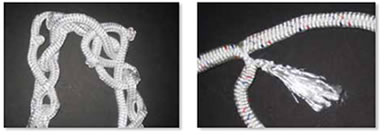
Researching an upcoming article on the effects of various cleaning chemicals on ropes, our testers scrubbed and machine-washed mountains of nylon and polyester rope of every description. Samples ranged from three-strand dock line encrusted in marine life to brand-new polyester double-braid line.
Our testing for that article continues, but we want to report one immediate finding relevant to any sailor who is wondering how to deal with old or dirty lines. Fully 70 percent of our test samples, including new and used line from New England Ropes (NER) and Samson Ropes, experienced failure of pre-spliced eyes; the buried portion of the core worked its way out of the main line and into the eye, where it carried zero load. In some cases, these failures were scarcely visible, while in others, the tail was exposed.
Another rope, the new double-braid dock line from NER produced large herniations of the core through the cover every six to 12 inches. Interestingly, none of the older braided lines suffered this type of failure.
Although some websites still recommend washing dock lines in a washing machine, we found that even when protected inside a pillowcase, herniations and failed splices were common. Generally, ropes should be washed by hand using mild soaps or just plain water. We will be taking a closer look at this topic next month in our full report on cleaning methods and the effects of cleaning chemicals.




































Thanks for very informative article! Whether I have a small or large boat, I need to have two or three mooring lines. It’s crucial to get the best rope for mooring lines so there’s assurance that my boat is safe and secured even when I can’t look after it.